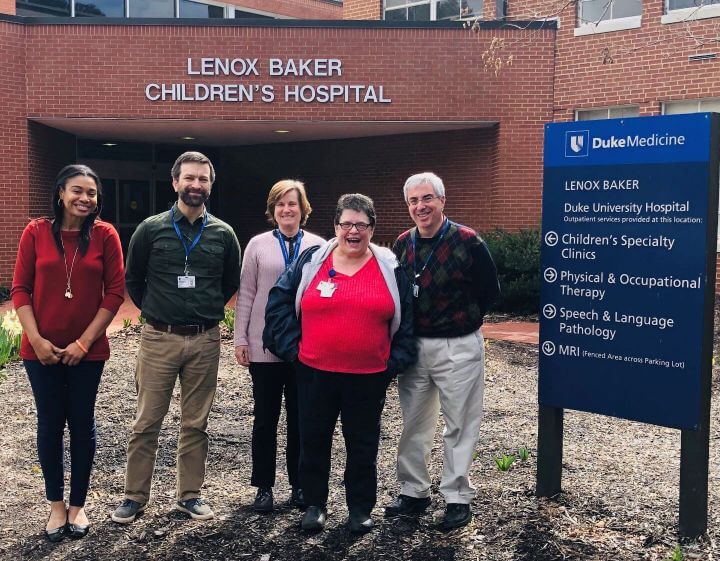The SMA Researcher Meeting is the largest research meeting in the world specifically focused on SMA and seeks to create open communication of early, unpublished data to accelerate the pace of research. The meeting also furthers research by building collaborations—including cross-disciplinary dialogue, partnerships, integration of new researchers and drug companies, and educational opportunities for junior researchers. This year, 530 researchers attended the meeting—a record number!
To highlight the most interesting new discoveries presented, we’ll be posting a series of summaries from the 2018 researcher meeting. This update covers the opening special session, “Clinical and Basic Questions of SMA in the Era of SMN Repletion: Challenge and Opportunity”. In this session speakers of various expertise on the topic at were invited to share their work with the SMA community. This session was moderated by John Day MD, PhD, Professor of Neurology and Pediatrics, Stanford University Medical Center.
Challenges and Opportunities in the Era of SMN Repletion
The advent of an FDA approved SMN enhancing drug has ushered in a new stage in the SMA community. As we celebrate the long awaited first drug approval, we know there remains much to be done. While Spinraza offers tremendous benefit to those with SMA, there is also a need for continued research. The development of additional therapies to be used independently or in combination with SMN enhancing approaches requires understanding more about SMA biology and disease mechanisms. Studying the “new” SMA phenotype after treatment will unveil new, unmet patient need, perhaps including extra-neuronal phenotypes and the need for such therapies. The goal of this session was to discuss these new challenges and opportunities. The session began by exploring the efficacy and unmet needs of current treatment and was followed by investigating patient phenotypes post treatment. Next, the neurodevelopmental need for prenatal SMN was discussed and its requirement for complete restoration of phenotype. Following that a discussion of the unanswered basic biology questions pertaining to SMA and their implications for therapy development was held. The panel discussion was focused on prioritizing future research endeavors to address unmet medical need for SMA patients.
Summary of Session Talks
The session began with an overview of the current status of the SMA field and therapeutics by John Day MD, PhD, Professor of Neurology and Pediatrics, Stanford University Medical Center. Next Thomas Crawford, MD, Professor of Neurology and Pediatrics, Johns Hopkins School of Medicine, discussed the unmet medical needs in SMA by comparing the efficacy in SMN enhancing therapeutics in pre-symptomatically versus symptomatically treated patients. Dr. Crawford discussed the need for additional therapeutics to meet the different needs of both of these patient populations. Dr. Day then gave an update on the unmet medical needs of adults and teens with SMA. He encouraged the SMA community to think about the unmet needs in the patient community and how these needs should guide future therapy development.
The next talk, given by Dr. Stephen Kolb MD, PhD, Associate Professor, Department of Neurology and Department of Molecular and Cellular Biochemistry, Ohio State University, was an overview of therapies in development and a discussion of gaps in the SMA drug pipeline. Dr. Kolb discussed both therapies in trials and the patient needs future therapies should address in order to have more complete and comprehensive treatments for all ages and stages of SMA. Next Dr. Basil Darras, MD, Professor of Neurology, Harvard Medical School, spoke about extra-neural and peripheral phenotypes of SMA. He discussed other cell types and organ systems affected by the low levels of SMN protein present in SMA and the need for therapies to target these tissues.
The next speakers addressed the biology of SMA and gave an overview of what we know and need to know in our understanding of the requirements of SMN protein for development. First, Dr. Charlotte Sumner, MD, Professor of Neurology, Johns Hopkins School of Medicine, discussed the developmental component of SMA, presenting her work highlighting prenatal requirements of SMN protein. Next Arthur Burghes, PhD, Professor of Molecular and Cellular Biochemistry, Ohio State University, gave an overview of unanswered questions regarding the biology of SMA and recapped what we do know. He discussed the need to continue to seek answers to the unknown questions in order to inform development of maximally effective treatments. Finally, the session concluded with a talk by Umrao Monani, PhD, Associate Professor of Pathology and Cell Biology, Columbia University. He highlighted the role of SMN at the neuromuscular junction (NMJ), the point at which the motor neuron meets the muscle, and explained how furthering our understanding of how SMN is functioning to maintain the NMJ is needed to better understand the biology of disease and inform treatment development.



